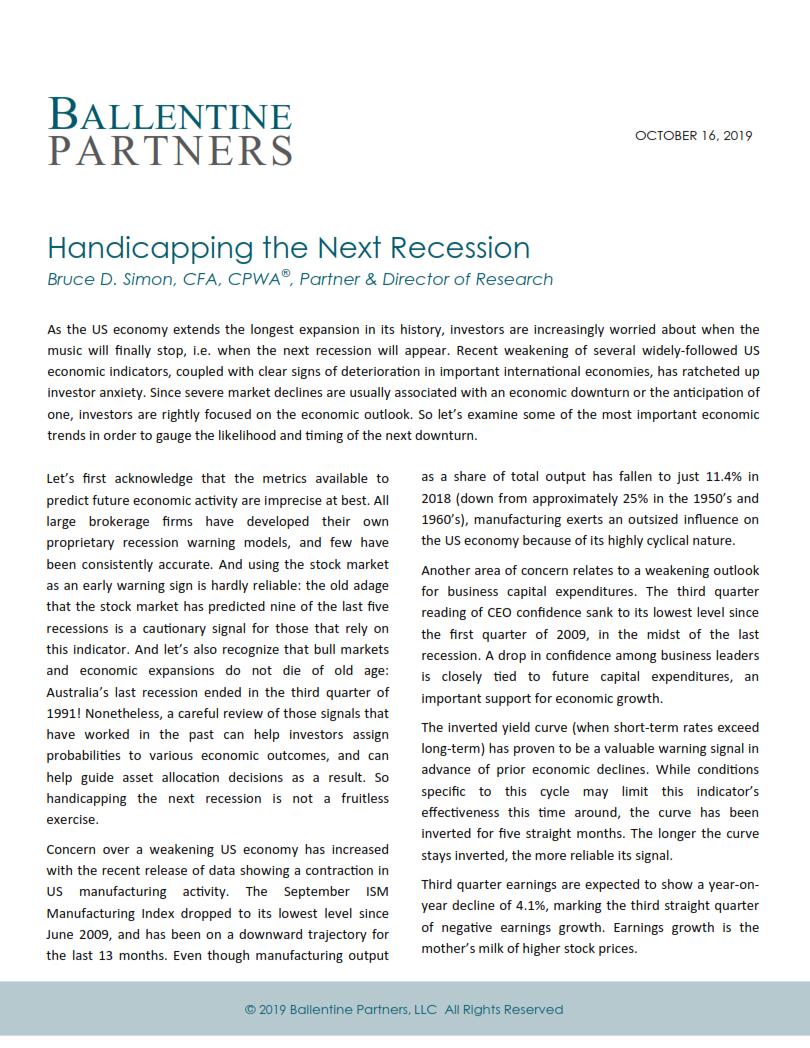As the US economy extends the longest expansion in its history, investors are increasingly worried about when the music will finally stop, i.e. when the next recession will appear. Recent weakening of several widely-followed US economic indicators, coupled with clear signs of deterioration in important international economies, has ratcheted up investor anxiety. Since severe market declines are usually associated with an economic downturn or the anticipation of one, investors are rightly focused on the economic outlook. So let’s examine some of the most important economic trends in order to gauge the likelihood and timing of the next downturn.
Let’s first acknowledge that the metrics available to predict future economic activity are imprecise at best. All large brokerage firms have developed their own proprietary recession warning models, and few have been consistently accurate. And using the stock market as an early warning sign is hardly reliable: the old adage that the stock market has predicted nine of the last five recessions is a cautionary signal for those that rely on this indicator. And let’s also recognize that bull markets and economic expansions do not die of old age: Australia’s last recession ended in the third quarter of 1991! Nonetheless, a careful review of those signals that have worked in the past can help investors assign probabilities to various economic outcomes, and can help guide asset allocation decisions as a result. So handicapping the next recession is not a fruitless exercise.
Concern over a weakening US economy has increased with the recent release of data showing a contraction in US manufacturing activity. The September ISM Manufacturing Index dropped to its lowest level since June 2009, and has been on a downward trajectory for the last 13 months. Even though manufacturing output as a share of total output has fallen to just 11.4% in 2018 (down from approximately 25% in the 1950’s and 1960’s), manufacturing exerts an outsized influence on the US economy because of its highly cyclical nature.
Another area of concern relates to a weakening outlook for business capital expenditures. The third quarter reading of CEO confidence sank to its lowest level since the first quarter of 2009, in the midst of the last recession. A drop in confidence among business leaders is closely tied to future capital expenditures, an important support for economic growth.
The inverted yield curve (when short-term rates exceed long-term) has proven to be a valuable warning signal in advance of prior economic declines. While conditions specific to this cycle may limit this indicator’s effectiveness this time around, the curve has been inverted for five straight months. The longer the curve stays inverted, the more reliable its signal.
Third quarter earnings are expected to show a year-on-year decline of 4.1%, marking the third straight quarter of negative earnings growth. Earnings growth is the mother’s milk of higher stock prices.
And finally, uncertainty surrounding the Trump Administration’s trade policy has left business leaders confused about making future plans. Beyond the immediate impact of higher costs for US consumers, businesses are making significant decisions about where to locate production facilities to support future growth. Without clear direction on the outcome of the trade talks, businesses are holding back.
All that may sound quite gloomy, so let’s review some of the more hopeful signs in the economy. The engine of US economic growth is consumer spending, and spending data continues to reflect solid growth. Buoyed by low unemployment, growing real incomes, and low interest rates, consumer spending is trending higher. Low mortgage rates have boosted housing starts and building permits, and housing sales are up on a year-over-year basis. Household balance sheets have also improved, with debt levels as a share of disposable income at its lowest level since 2001.
The labor market remains tight. At 3.5%, the unemployment rate sits at a 50-year low, and while job growth has moderated somewhat over the past year, nonfarm payrolls have increased at a rate of 179,000 per month over the past year. As long as businesses are adding to payrolls, a US recession remains unlikely.
Lastly, the Fed appears ready to further lower interest rates should conditions deteriorate. Financial markets are expecting at least three more rate cuts in the next twelve months.
Putting all of these factors together, we assign a probability of a recession in the US over the next twelve months to be about 1 in 3: not our base case but certainly within the realm of possibility. Our strategy is to remain broadly diversified, hold assets that are likely to cushion a possible downturn, and be prepared to capitalize on opportunities should markets stumble.
Learn more about Bruce Simon, our Director of Research.
This report is the confidential work product of Ballentine Partners. Unauthorized distribution of this material is strictly prohibited.
The information in this report is deemed to be reliable but has not been independently verified. Some of the conclusions in this report are intended to be generalizations. The specific circumstances of an individual’s situation may require advice that is different from that reflected in this report. Furthermore, the advice reflected in this report is based on our opinion, and our opinion may change as new information becomes available.
Nothing in this presentation should be construed as an offer to sell or a solicitation of an offer to buy any securities. You should read the prospectus or offering memo before making any investment. You are solely responsible for any decision to invest in a private offering.
The investment recommendations contained in this document may not prove to be profitable, and the actual performance of any investment may not be as favorable as the expectations that are expressed in this document. There is no guarantee that the past performance of any investment will continue in the future.





